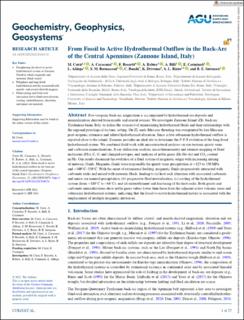| dc.description.abstract | Post-orogenic back-arc magmatism is accompanied by hydrothermal ore deposits and mineralizations derived from mantle and crustal sources. We investigate Zannone Island (ZI), back-arc Tyrrhenian basin, Italy, to define the source(s) of mineralizing hydrothermal fluids and their relationships with the regional petrological-tectonic setting. On ZI, early Miocene thrusting was overprinted by late Miocene post-orogenic extension and related hydrothermal alteration. Since active submarine hydrothermal outflow is reported close to the island, Zannone provides an ideal site to determine the P-T-X evolution of the long-lived hydrothermal system. We combined field work with microstructural analyses on syn-tectonic quartz veins and carbonate mineralizations, X-ray diffraction analysis, microthermometry and element mapping of fluid inclusions (FIs), C, O, and clumped isotopes, and analyses of noble gases (He-Ne-Ar) and CO2 content in FIs. Our results document the evolution of a fluid system of magmatic origin with increasing mixing of meteoric fluids. Magmatic fluids were responsible for quartz veins precipitation at ∼125 to 150 MPa and ∼300°C–350°C. With the onset of extensional faulting, magmatic fluids progressively interacted with carbonate rocks and mixed with meteoric fluids, leading to (a) host rock alteration with associated carbonate and minor ore mineral precipitation, (b) progressive fluid neutralization, (c) cooling of the hydrothermal system (from ∼320°C to ∼86°C), and (d) embrittlement and fracturing of the host rocks. Both quartz and carbonate mineralizations show noble gases values lower than those from the adjacent active volcanic areas and submarine hydrothermal systems, indicating that the fossil-to-active hydrothermal history is associated with the emplacement of multiple magmatic intrusions. | en_US |

